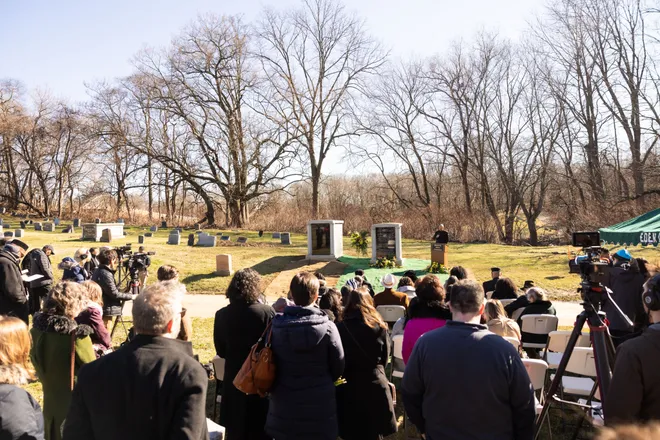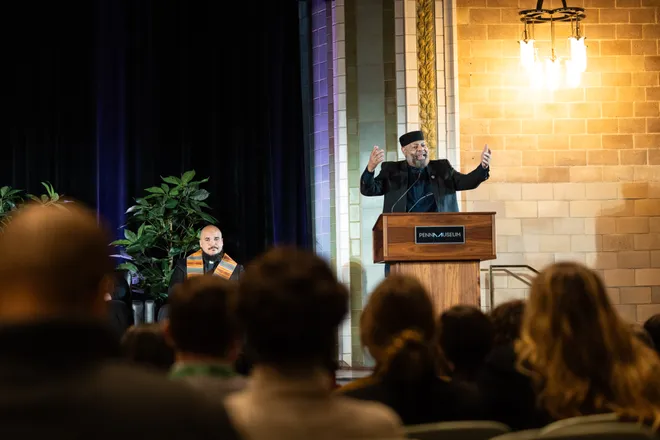Penn Museum buried remains of 19 Black Philadelphians. But a dispute is still swirling.

Samuel Morton, a 19th century physician and lecturer motivated by white supremacist beliefs, unethically collected hundreds of human skulls in the course of his research, including 19 that belonged to Black Philadelphians.
The Penn Museum, where they had been since they were transferred to the institution from the Academy of Natural Sciences in 1966, knows the crania should not be kept there, that the remains should be shown the respect, dignity and humanity they deserve.
Those are the points of agreement. But how and when those remains were laid to rest, and who was − and was not − included in the process are the subject of bitter contention, especially after a private interment in late January and dedication ceremony days later.
That disagreement is not unique to the Penn Museum, the University of Pennsylvania or Philadelphia. It's part of a larger national reckoning over science, history and anthropology, over the racism that was often part of the pursuit of knowledge, over art and artifacts obtained through unscrupulous means or outright theft, over people whose bodies were used without their consent or the consent of their loved ones.
A push to return stolen artifacts:Experts say that requires an 'institutional transformation.'
aAliy Muhammad, a writer and community organizer in West Philadelphia, became aware of the Morton Cranial Collection in 2019 during a symposium at the university.
"I was angry and moved to take action," they said. They organized a Change.org petition to have the Philadelphians' remains repatriated, writing op-ed pieces in the Philadelphia Inquirer and other publications saying: "At the very least Penn can disavow Morton, and bury our ancestors."
The museum did inter the remains, privately placing them in a mausoleum in a historic Black cemetery just outside Philadelphia in late January and then commemorating them in a two-part ceremony Saturday at the museum and at Eden Cemetery.
But Muhammad and others say the museum hurried the interment, did not include the community in the interment process and continues to "deny these Black ancestors' dignity" in the same way Morton did.
"We can give them a respectful and sacred burial," said Muhammad, who lives in West Philadelphia and traces their family history in the same neighborhood as the University of Penn back to the late 1800s. "Instead, Penn decided to rush the interment. We want to see Penn give up control of these remains to the community, to Black Philadelphians."

A long and complicated process
Penn Museum director Christopher Woods said the institution has been as transparent as possible and has "recognized and prioritized the human dignity" of the remains.
A page on the museum website chronicles the museum's ongoing efforts toward "repatriation and repair," including its own research into the Morton collection, formation of a community advisory committee to determine the best way to honor the remains and petitioning the city's Orphan's Court for burial and protection of the remains.
None of the remains have been identified, except for those belonging to John Voorhees, who died in 1846, nor do any show evidence of prior burial.
Woods told USA TODAY that through the process, which included legal notices and news coverage in local newspapers, there was scant opposition to interring the 19 crania − certainly nothing like the widespread outrage that came with revelations that remains of victims of the 1985 MOVE bombing were in the possession of a museum researcher.
News reports about the Morton collection "portray this as a huge disconnect with community," Woods said. "But no one has come to us about (the Morton remains)" other than Muhammad and Lyra Montiero, a Rutgers professor and anthropological archaeologist who along with Muhammad launched Finding Ceremony, an initiative aimed at repatriation of the MOVE and Morton remains.
"(The community advisory board) emphasized to me that these people's remains to not belong in some museum storeroom and that they should be laid to rest," Woods said. "If we hadn't gone through this process, they would still be languishing in some storage room."
Who decides what makes a 'community'?
Muhammad believes the community advisory committee convened by Penn is a misnomer, and that has tainted how the remains are laid to rest.
"Penn is misusing the word 'community,'" they said. "It's not about positionality; it's about rooted Black people who care about (the owners of the remains) in life and after life."
Members of the advisory board, they said, are affiliated with the city, the university or the museum and "have limited purview and understanding of what's at stake."
Muhammad believes the museum should have engaged a wider swath of the Black community in Philadelphia and proceeded more deliberately to find out more about the people whose remains Morton collected to see whether descendants could be located and informed. It was not the museum's place, they said, to decide the ultimate fate of the remains.
Charles Lattimore Howard, the university chaplain and vice president for social equity and community, rejected the idea that his employment at Penn precludes him from wanting the institution to properly honor the Black Philadelphians' remains.
He described "a deep resentment and grief and pain" upon learning of Morton's racist motivations and the dangers posed by his ideas.
"And the second level of it was that this disregard for Black bodies and the holding onto of these skulls without interring them added to the pain and shock of the situation," said Howard, who is Black.
Woods, he said, took the initiative to right institutional wrongs that his predecessors did not and has acted "with integrity and a commitment to getting it right," in honoring the remains.
"I get that Penn is what it is, a big, old institution that's done a lot of good and a lot that's not good," said Howard, a Baltimore native who's lived in Philadelphia for 28 years.
"But we live here, too, and we're part of the history of Black liberation. That's not lost just because I have a Penn ID in my pocket."
Renee McBride-Williams has lived in West Philadelphia for about 60 years and is not affiliated with Penn. She served on the advisory committee, invited by Penn because of her leadership of Cedar Park Neighbors.
"I believe if you broke it, you fix it," she said. "So they should be responsible for the burial of as many of the remains as possible, because these were human beings. To live in poverty as they did, to die of a disease, to have your corpse taken ... I felt as though I needed to speak for these people who could not speak."
She and other committee members spoke with others in the community, too, to learn what they thought. It also mattered to her that Woods and Tia Jackson-Truitt, Penn Museum's chief diversity officer, are both Black.
"It had to begin somewhere. It was a matter of doing the right thing, and it felt right to me to have them interred with some dignity. How much longer did you want to keep them out, not resting in peace?"
Howard, the Penn chaplain, acknowledged that many Black people rightfully distrust big institutions such as Penn.
"But one thing I've thought a lot about is that everyone involved, on university side or community members who’ve been critical, is trying to do what’s right," he said.
"Everyone’s heart is in the right place."

Disclaimer: The copyright of this article belongs to the original author. Reposting this article is solely for the purpose of information dissemination and does not constitute any investment advice. If there is any infringement, please contact us immediately. We will make corrections or deletions as necessary. Thank you.



